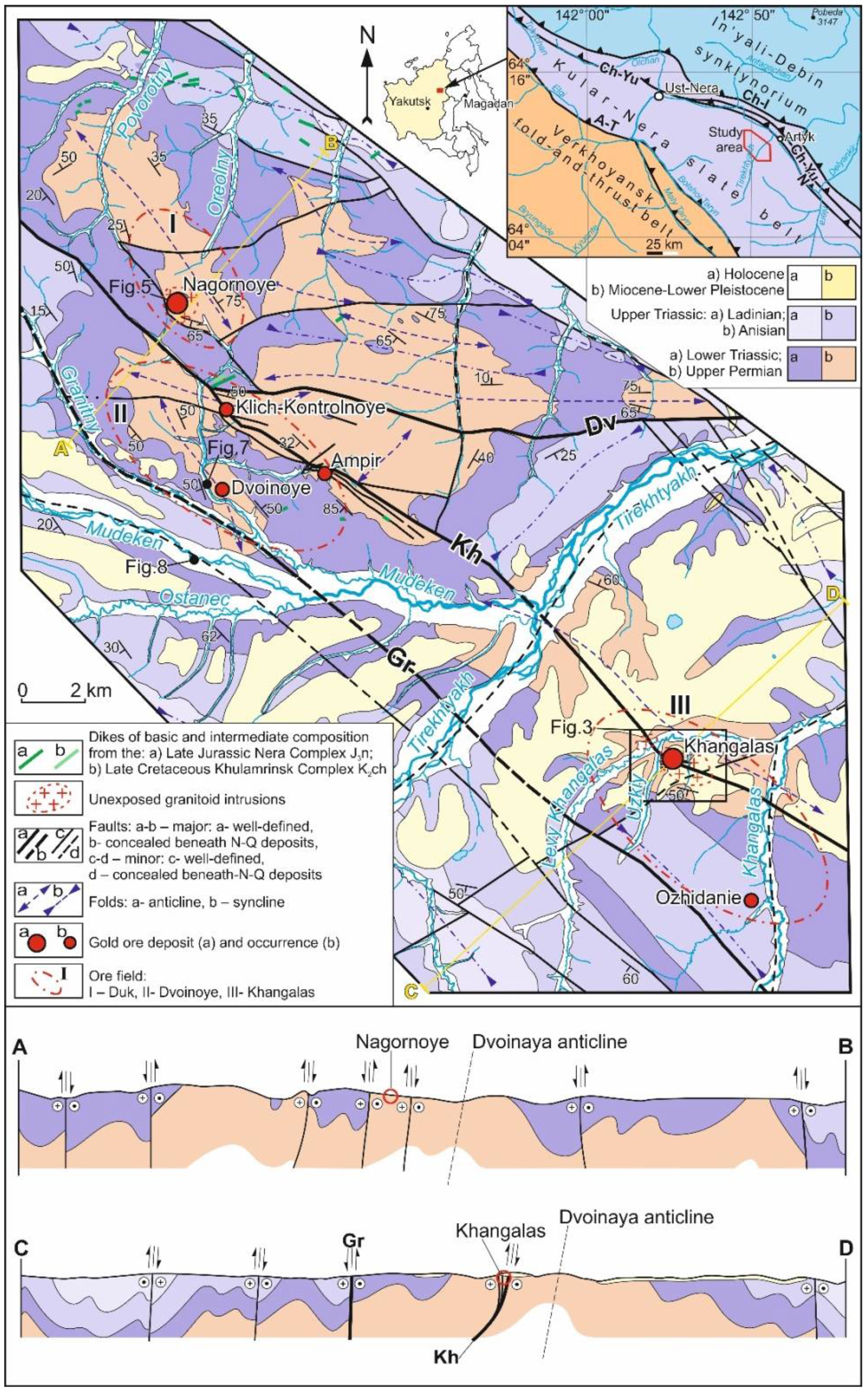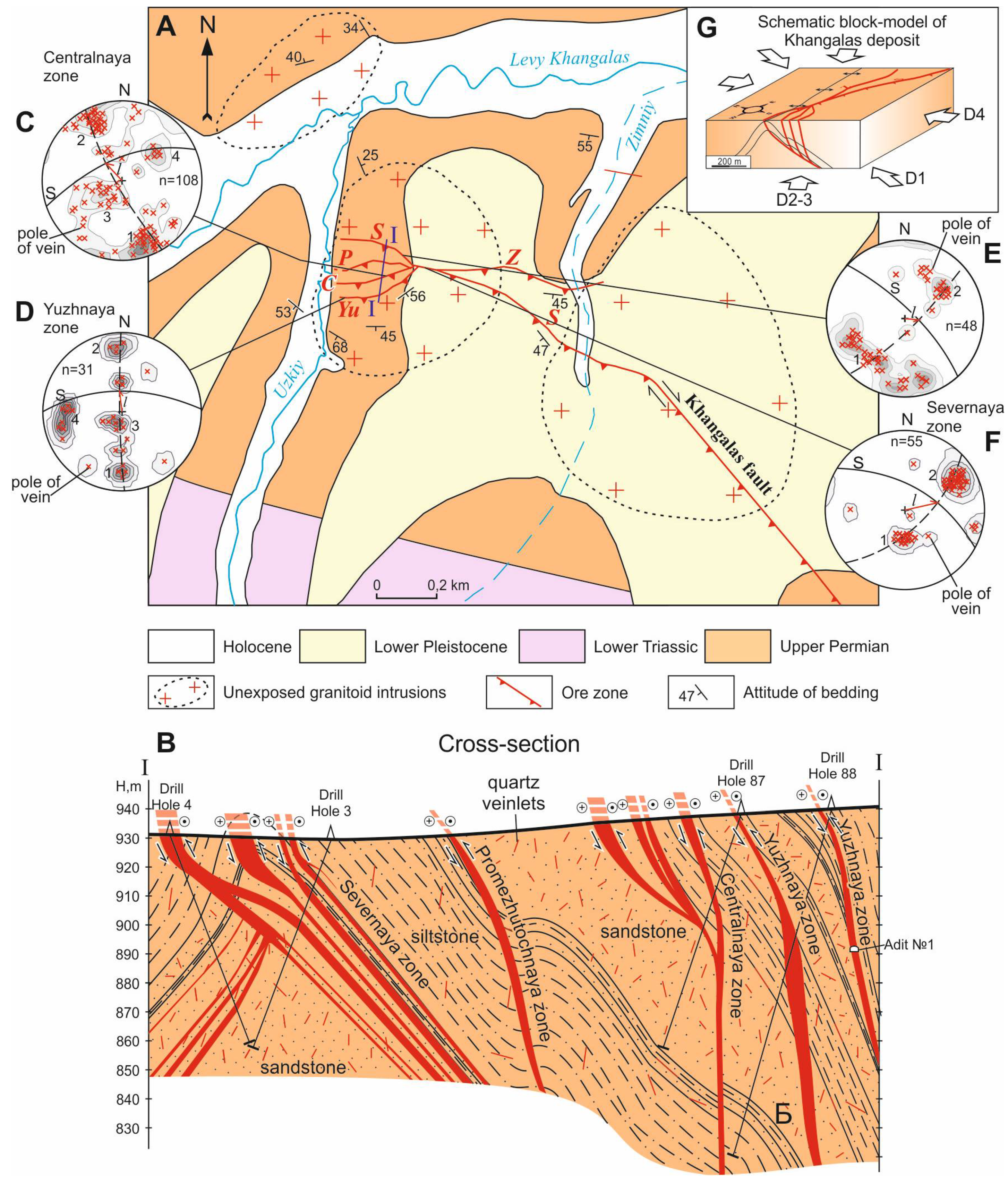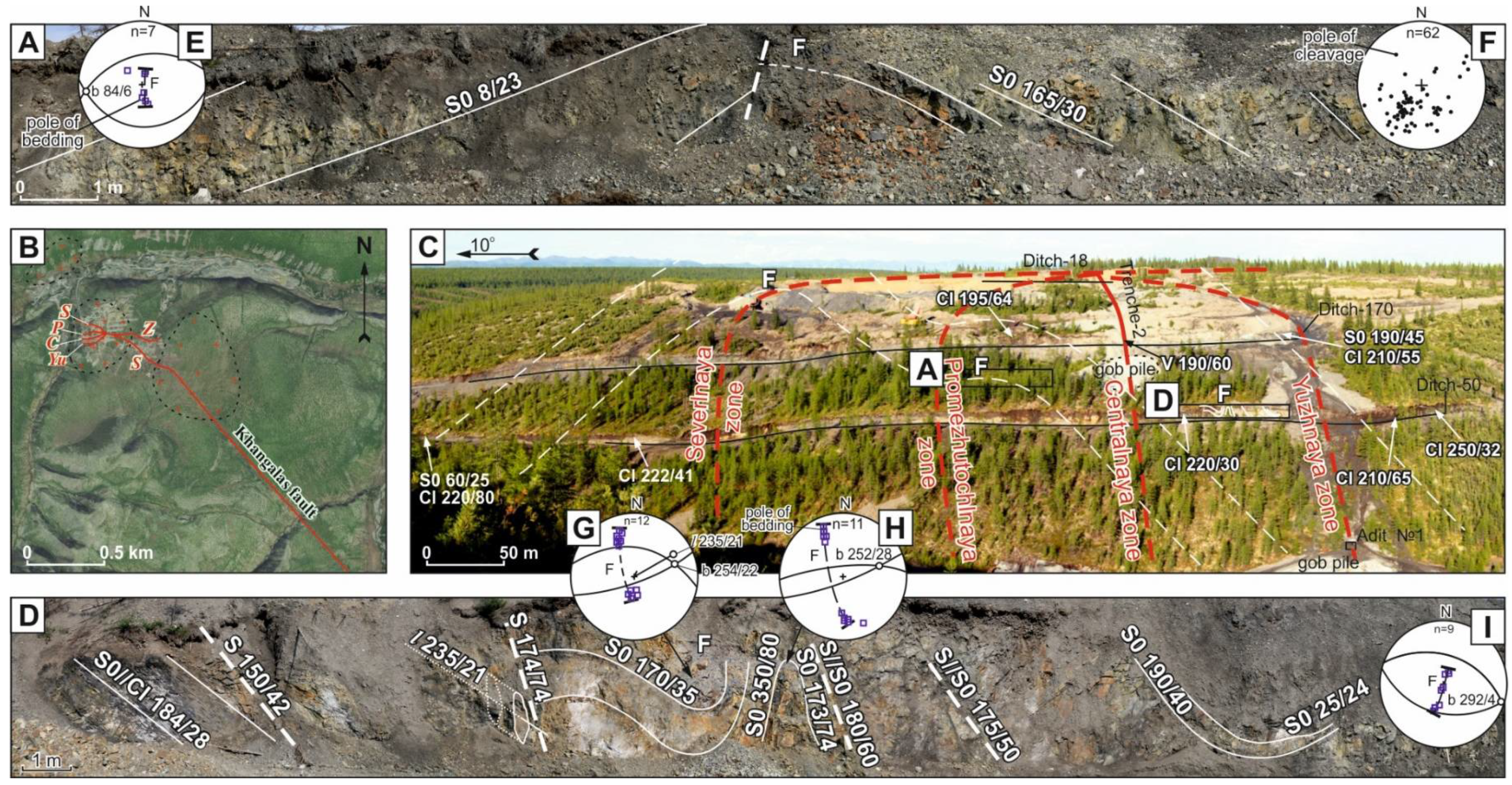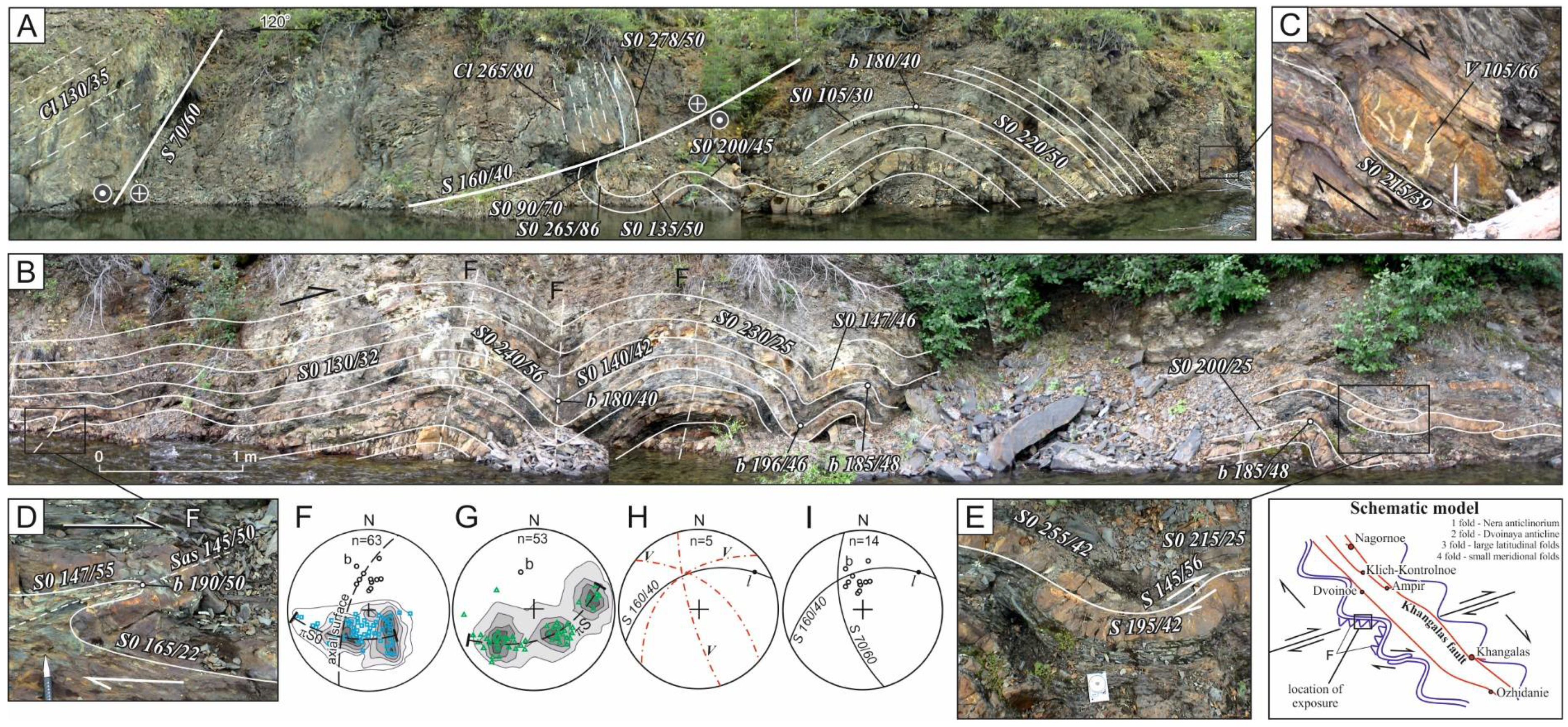1. Introduction
The Khangalas ore cluster (KOC) is located in the southeastern part of the Kular-Nera slate belt of the Verkhoyansk-Kolyma folded region in northeast Russia. It was discovered in the 1940s. Rich placer deposits with large gold nuggets are known there. Commercial exploitation of the KOC commenced in the latter half of the 20th Century and continues to present day. At an early stage of geologic investigation (1940–1980), considerable attention was given to concordant ore bodies confined to the limbs of brachyanticlinal folds [
1]. Then, in the late 1980s to the early 2000s, mineralized fault zones of complex structure with diverse mineralization were identified and investigated, which considerably enlarged the mineral resource potential of the KOC [
2,
3]. Southeasterly, in the Upper Kolyma gold district with a similar geological-structural setting, several small- and medium-sized gold deposits are found, such as Vetrenskoye, Chay-Yuruye, Svetloye, etc. [
4,
5]. Gold mineralization of the KOC is of the orogenic type, which is characterized by a close relationship with Late Jurassic-Neocomian tectonomagmatic events in the Verkhoyansk-Kolyma folded region [
6,
7,
8,
9,
10]. The paper presents new data on the KOC geology obtained by the authors in the last few years, which provide a better understanding of the relations between folds, faults and mineralization in the region.
2. Materials and Methods
Structural-tectonic factors are among the most important in controlling localization of orogenic Au-quartz deposits [
11,
12]. Structural-kinematic studies in the Khangalas ore cluster were conducted using up-to-date methods [
13,
14,
15,
16,
17]. The morphology of ore veins in natural exposures and mine workings was studied and their relations to geological structures established. Interactions between the veins and faults were studied using the belt method [
18]. This is based on the regular position of vein poles relative to faults in stereographic projection. The method enables determination of the sense of displacement during vein formation [
18]. Measurements of planar and linear structures (bedding, cleavage, vein-veinlet bodies, faults, ore zones, jointing, fold hinges, boudinage, slickenlines, etc.) were made. The kinematics of main deformation stages and the paleo-orientation of stress were reconstructed relative to major deformation structures of NW strike. Structural data were statistically analyzed and plotted on the upper hemisphere of the Wulff stereographic net.
In 2005, detailed field studies and structural mapping were conducted at the Nagornoye deposit and the Dvoinoye, Ampir and Klich-Kontrolnoye occurrences, at Mudeken and other localities and in 2014 and 2017 at the Khangalas deposit and Ozhidaniye occurrence. The nomenclature of structural elements is taken from [
19]. Planar structures (S) are given as dip azimuth/dip angle (e.g., 90/60 denotes eastward dip at 60°). For linear deformation elements (
l), denotation plunge azimuth/plunge angle is used (e.g., 215/45 means plunge azimuth of 215° and plunge angle of 45°). Signs S1 and
l1 denote the relation of a structural element to a particular deformation stage (D1) event. The studies enabled refining the general architecture of the region, revealing the particularities of the ore-controlling structures, identifying key structural elements, reconstructing the chronology of deformational events and mineralization and establishing their relationship with regional geodynamic events in northeast Asia.
3. Geology of the Southeastern Part of the Kular-Nera Slate Belt and the Khangalas Ore Cluster
The Kular-Nera slate belt (KNSB) is situated in the central part of the Verkhoyansk-Kolyma folded region [
6]. It is mainly composed of Upper Permian, Triassic and Lower Jurassic terrigenous rocks. Extensive faults separate the belt from adjacent tectonic structures. In the northeast, it is separated from the In′yali-Debin synclinorium by the Charky-Indigirka and Chai-Yureye faults, and in the southwest, the Adycha-Taryn fault separates it from structures of the passive margin of the North Asian craton. The structural pattern of KNSB is defined by linear folds and faults of NW strike that developed over several deformation stages. Within the KOC, NW-striking faults represent branches of the Nera Fault, which manifests itself as 4 km-wide zones of intensive deformations and subvertical foliation of the rocks. Dextral strike-slip motions have been reported along the Nera Fault [
20].
Magmatism is poorly manifested in KNSB. It is mainly represented by granitoid massifs, subvolcanic magma of dacite composition and dikes belonging to the NNW-striking Tas-Kystabyt magmatic belt. They were formed in Late Jurassic-Albian times [
21]. Various tectonomagmatic events characteristic of the Late Jurassic-Late Cretaceous history of the eastern margin of the North Asian craton are manifested within KNSB [
6,
22,
23]. The Late Jurassic-Early Cretaceous was marked by accretion and collision of the Kolyma-Omolon microcontinent against the craton margin and by subduction processes in the Uda-Murgal island arc. These events produced different-age fold and thrust structures, S- and I-type granitoids and orogenic gold deposits. In the Late Neocomian, the direction of the Kolyma-Omolon microcontinent motion and of subduction in the Uda-Murgal arc changed [
6]. At that time, left-lateral strike slip motions first occurred in KNSB along NW-trending faults. Post-accretionary tectonic events and Au-Sb and Ag mineralization events were related to Late Cretaceous subduction within the Okhotsk-Chukotka arc [
24].
The Khangalas ore cluster is located in the arch of the Nera anticlinorium that is represented in the study area by the NW-striking Dvoinaya anticline composed of dislocated Upper Permian and Lower-Middle Triassic terrigenous rocks (
Figure 1). The Upper Permian (P
2) deposits make up the core of the Dvoinaya anticline. The lower part of the section consists of massive brownish-grey and grey greywacke sandstones with thin siltstone interbeds. The upper part is dominated by an 800 m thick sequence of dark-grey and black siltstones with inclusions of pebbles of sedimentary, magmatic and metamorphic rocks. The limbs of the Dvoinaya anticline are made of 680–750 m thick Lower-Middle Triassic deposits (T
1), mainly dark-grey shales, mudstones and siltstones with rare interbeds of light-grey sandstones. The Middle Triassic deposits of the Anisian stage (T
2a) are represented by a 700–800 m thick sequence of alternating sandy siltstones and siltstones with rare fine-grained sandstone interbeds. The Ladinian strata (T
2l) are chiefly made of interbedded siltstones and sandstones with a total thickness of 850–950 m.
The main ore-controlling rupture dislocations are the Khangalas, Dvoinoy and Granitny faults represented by zones of breccia and fracture, low sulfidation of rocks and quartz-carbonate vein mineralization (
Figure 1). The Khangalas Fault crosscuts the Khangalas ore cluster in a northwest direction. It controls localization of the Khangalas deposit and Ampir and Klich-Kontrolnoye occurrences. Within the study area, the exposed fault changes its strike from NW-SE to E-W and has a dip direction to S-W and S. The bedding of rocks exposed in the S-W wall strikes N-W, and rocks of the N-E wall strike NE-SW and E-W. The Dvoinoy Fault strikes E-W, and its fault plane is subvertical. In the central part of the KOC, northward of the Klich-Kontrolnoye occurrence, the Dvoinoy Fault adjoins the Khangalas Fault. The northeastern branch of the Dvoinoy Fault controls mineralization at the Nagornoye deposit. The rocks of the S wall of the fault have a N-E strike, while those of the N one strike E-W. The Granitny Fault is located in the southwestern part of the KOC. Outside the Khangalas ore cluster, the Ala-Chubuk massif of biotite granites is confined to it.
Magmatic activity is manifested by rare mafic and intermediate dikes of the normal and subalkaline series of Late Jurassic (Nera Complex (J
3n)) and Late Cretaceous (Khulamrinsk Complex (K
2ch)) age (
Figure 1). The Nera magmatic complex includes basalt, gabbro and diorite porphyry dikes that extend for a distance from a few tens of meters to 2 km and have NE strike and a thickness of 1–20 m. The dikes underwent alteration. They contain quartz-carbonate veinlets. The Khulamrinsk magmatic complex consists of rare trachybasalt dikes extending for 200–500 m. They have a NW strike and are 1–10 m thick.
At 7 km to the northwest of the Khangalas ore cluster is the exposed Ala-Chubuk massif of biotite granites. The K-Ar age of the massif determined on orthoclase from porphyry phenocrysts is 145.0 ± 3.0 Ma and on biotite from the groundmass 149.0 ± 3.0 Ma [
25]. The available geophysical data imply the presence of unexposed intrusions of similar composition at the Nagornoye and Khangalas deposits [
25]. The Khangalas, Dvoinoye and Duk ore fields are identified within the KOC. The first field occurs in the southeast of the ore cluster and includes the Khangalas deposit and the Ozhidaniye occurrence. To the northwest of them are the Klich-Kontrolnoye, Dvoinoye and Ampir occurrences belonging to the Dvoinoye ore field. The Duk ore field includes the Nagornoye deposit. The ore bodies consist of extensive mineralized fault zones and concordant and cross-cutting gold-quartz veins and veinlets with simple mineral composition. The amount of ore minerals does not exceed 1–3%. These are arsenopyrite, pyrite, galena, sphalerite, chalcopyrite and native gold with 820–830‰ fineness and rare antimonite and Pb-sulfosalts. Quartz is the main gangue mineral, with less abundant carbonates (calcite and siderite) and chlorite. A series of successive mineral assemblages are identified in the ores of the deposits. These are pyrite-arsenopyrite-quartz metasomatic, quartz-pyrite-arsenopyrite vein, chalcopyrite-sphalerite-galena and sulfosalt-carbonate assemblages. The early pyrite-arsenopyrite-quartz mineralization is developed in wall-rock metasomatites. It is represented by irregular disseminations of pyrite and arsenopyrite metacrysts and by thin quartz streaks. Pyrite prevails over arsenopyrite. Minerals of the metasomatic assemblage are characterized by euhedral and subhedral crystals and a streaky-disseminated structure. Pyrite and arsenopyrite grains show evidence of deformation and corrosion. Pyrite and arsenopyrite of the early vein assemblage occur as disseminated euhedral grains and intergrowths. Pyrites of the vein assemblage contain Co, Sb, As, Ni, Cu and Zn trace contaminants. Minerals of the productive chalcopyrite-sphalerite-galena assemblage sporadically occur as disseminations and small aggregates in milk-white quartz and as microinclusions in early sulfides. The principal mineral of the sulfosalt-carbonate assemblage is siderite. Sulfosalts are represented by boulangerite, tetrahedrite and bournonite.
Microthermometric studies of the fluid were conducted at the laboratory of the M.K. Ammosov North-Eastern Federal University on an optical microscope AxioScope.Al fitted with a motorized heating stage (up to 600 °C) and a liquid nitrogen sample cooling system (down to −196 °C) (LNP95). Analyses were made on milk-white quartz samples from the ore veins. The results of thermo- and cryo-metric studies showed that ore-forming fluids of the KOC originated at temperatures of 310–330 °C and a pressure of 0.9 kbar. The data obtained suggest that gold mineralization was formed at a depth of about 3.5 km.
Age determinations are scarce for the KOC mineralization. The K-Ar sericite age of the Nagornoye deposit is 130.0 ± 4.0 Ma [
23]. The authors of the given paper conducted Re-Os dating of gold (Sample Number X-45-14) from a quartz vein from the Yuzhnaya ore zone of the Khangalas deposit at the Center of Isotope Research of the Karpinsky All-Russian Scientific-Research Geological Institute (St. Petersburg, Russia). The isochron Re-Os age of gold was 137.0 ± 7.6 Ma. This indicates that productive orogenic gold-quartz mineralization of the region was formed in Valanginian-Hauterivian times.
The mineralized brittle fault zones consist of breccias and blocks of quartzose sandstones and siltstones and are often accompanied by concordant (a few cm to 1–2 m thick, in swells up to 5 m) and cross-cutting quartz veins and veinlets and disseminated sulfide mineralization (
Figure 2). They are mainly localized in sandstones and at their contacts with siltstones and have conformable and crossing relations with the host rocks. The ore zones underwent strong supergene alteration as indicated by the presence of Fe oxides, sulfates, clay minerals, etc. Nesterov N.V. [
26] has reported on a secondary gold enrichment at the Khangalas deposit. The quartz veins are often deformed in the mineralized fault zones, which is indicative of post-ore deformation. The host siltstones and sandstones contain disseminated sulfide mineralization (
Figure 2D) represented by fine to coarse crystalline arsenopyrite and pyrite occurring as crystals, nests and veinlets.
5. Discussion
Structural-kinematic analysis of deformation elements within the KOC revealed specific structures of deposits and occurrences.
Figure 9 shows stereograms of major structural elements of the KOC (bedding, cleavage, quartz veins and veinlets, as well as mineralized fault zones). Fold structures of the Khangalas deposit have NW-SE to E-W strike. Fold hinges (b1) dip to WSW at angles varying from 4–28°. Steep dip angles are due to superposed strike-slip deformations. Hinges of the third order F1 folds smoothly undulate in the direction of NW regional folding within the Nera anticlinorium.
Cl1 cleavage at the Khangalas deposit has a NW-SE strike. In the fault zones, cleavage is deformed by late strike-slip faulting, as well as bedding. In stereographic projections, poles of quartz veins and veinlets are arranged along subvertical belts. From the aforesaid, it appears that the formation of auriferous quartz veins and veinlets is related to major fold and thrust deformations of D1 stage (J
3-Knc). Faults and ore zones at the Khangalas deposit have sublatitudinal and, more rarely, northeast and northwest strike. The majority of them dip S at 30–60°.
F1 compressed folds of sublatitudinal strike are deformed, like Cl1 cleavage at the Nagornoye deposit, by late strike-slip faults. This led to the formation on the limbs of F1 folds of F4 open folds with steep (b4) hinges plunging to NNE and SSW. On the stereogram, vein bodies form a steeply-dipping belt of poles. Faults and ore zones are, for the most part, interstratal and have latitudinal to NE-SW, rarely NW-SE orientation.
Bedding of rocks in the Dvoinoy ore field is characterized by NW-SE and NE-SW strike related to two different deformation stages: D1 and D4, respectively. Cleavages of NW-SE and E-W orientation are recognized. The first cleavage Cl1 is associated with the D1 stage. It was formed in relation to early fold-and-thrust dislocations. Cleavage Cl4 is related to the right-lateral strike-slip stage (D4). Fault zones within the Dvoinoye ore field have mostly WNW-ESE strike.
The results of studying other deposits within the Kular-Nera slate belt [
22,
31,
32,
33,
34,
35,
36] in combination with the available information on the general tectonic and metallogenic evolution of the Verkhoyansk-Kolyma folded region [
6,
7,
9,
37] and the data on the relationships between the mapped structural elements obtained in this study indicate that deformation occurred in four stages: D1, D2, D3 and D4 (
Table 1).
D1 and D2 deformations occurred in the Late Jurassic-Early Cretaceous in response to frontal (D1) and then oblique (D2) accretion of the Kolyma-Omolon microcontinent to the North Asian craton margin, as well as subsynchronous subduction-related processes within the Uda-Murgal active margin. The first Late Jurassic deformation event (D1) is characterized by development of NW-trending tight and isoclinal folds (F1), interstratal detachment thrusts at the contacts of rocks with contrasting physical-mechanical properties and ramps. The sense of tectonic transportation is SW. Mineralization consists of rare non-auriferous quartz-chlorite or quartz-chlorite-calcite veins occurring throughout the area. The thickness of the veins does not exceed a few tens of centimeters. Often, the veins are concordant with the host rock bedding.
During subsequent progressive deformation, the early interstratal detachment thrusts are deformed into reverse faults. Thrust deformations are associated with linear open and tight folds (F1) of the concentric type with prevailing NW-SE strike and platy cleavage. Within the ore zones, F1 folds form bands of intense deformation up to a few hundreds of meters wide. On the limbs of F2 folds, one can observe rootless intrafolio fold hinges of the early F1 folds [
8] and slickenlines oriented in the direction of dip. This stage was marked by the origination of orogenic ore-magmatic systems and intrusion of granitoids and mafic and intermediate dikes of the Late Jurassic Nera complex, which produced vein, vein-veinlet and veinlet-disseminated gold-quartz (gold-sulfide-quartz) mineralization. According to the mineralogical data, mineralization was formed at a depth of about 3.5 km. The ore bodies are localized in mineralized fault zones, in the crests of folds (saddle veins) and sandstone strata (vein-veinlet bodies).
D2: The Late Neocomian is the period when the direction of motion of the Kolyma-Omolon microcontinent and of subduction in the Uda-Murgal arc began changing [
6]. Within the Kular-Nera slate belt, the second stage of accretion (Aptian, Lower-Cretaceous) is characterized by the first left-lateral strike-slip motions (D2) on NW-striking faults, which occurred under prevailing W-E compression. At that time, intrusions of subvolcanic granite-porphyry were formed [
24]. Strike-slip deformations reworked hydrothermal-metamorphogenic and gold-quartz (gold-sulfide-quartz) mineralizations causing their corrosion and remobilization, as well as the dynamic metamorphism of ore bodies. In association with strike-slip faults, F2 open folds were formed. The width of the mapped folds ranges up to a few hundred meters, but wider folds are likely, as well. Fold hinges plunge to N-E and N. At the contacts of mineralized fault zones, one can see variously-oriented subhorizontal slickenlines superposed on vertical ones.
D3: Post-accretionary tectonic events are associated with Late Cretaceous subduction in the Okhotsk-Chukotka arc [
6,
24]. This stage is marked by the formation of N-S and NE-SW folds (F3) with steep hinges and by activation of earlier structures, including ore-controlling ones. Note the similar kinematics of D2 and D3 deformations. F3 folds have various morphologies: from open symmetric to tight overturned ones. Characteristic are sinistral motions most widely manifested along the axial part of the Adycha-Taryn Fault [
36].
At that stage, gold mineralization was superposed by Late Mesozoic antimony mineralization [
24]. As shown in [
36], a strong influence of Sb-bearing fluid caused significant reworking of the mineral complex of gold mineralization in the Adycha-Taryn zone. Formation of Sb mineralization was related to leaching and replacement processes that led to the formation of new mineral parageneses. Quartz-sericite metasomatites of the gold ore stage are characterized by the superposed late carbonate-paragonite-pyrophyllite-dickite paragenesis. Pyrite and arsenopyrite metacrysts are replaced by a mixture of antimonite and pyrophyllite. In the ore zones, late ore deposition is manifested by berthierite and antimonite. They form numerous streaks in milk-white quartz cementing its fragments and forming brecciated zones. The broken down milk-white quartz is freed from impurities along the fluid conductors. Solution occurs along the quartz grain boundaries. Transparent regenerated quartz forms streaks and aggregates of small (up to 1–2 mm) prismatic crystals, with pyramidal terminations. The early sulfides and sulfosalts also underwent intensive corrosion, leaching and redeposition, which led to the formation of an association of regenerated minerals. Microcrystals of the regenerated high-fineness (900–1000%) gold are often surrounded by reaction rims of aurostibite and antimony gold (Sb up to 8%) [
36].
D4: The latest and fourth deformation event (D4) is characterized by dextral strike-slip faulting, refolding of rocks, reactivation of the earlier ore-controlling structures, as well as the formation of E-W folds and cleavage. Maastrichtian-Early Eocene strike-slip deformation is inferred to be related to oblique subduction of the Pacific Ocean plates beneath the eastern margin of north Asia [
6] and/or to the formation of a transform margin in northeast Asia [
38].
6. Conclusions
Studies of deformation structures of the Khangalas gold-ore cluster showed that they were forming over a long time during the course of the Late Jurassic-Neocomian accretionary and Late Cretaceous-Early Paleocene post-accretionary events in the Verkhoyansk-Kolyma folded region.
The first deformation event (D1) was characterized by the development of NW-striking tight to isoclinal folds of the first generation (F1) and interstratal detachment thrusts. Major folds, extensive thrusts, boudinage, cleavage, Au-bearing mineralized fault zones and quartz-vein mineralization were formed in the conditions of the tectonic stress field characteristic of reverse and thrust faulting, with the horizontal σ1 and vertical σ3. The D1 stage was progressive deformation under a contractional regime. In the zones of regional faults, where deformations are most intensely manifested, inter- and intra-stratal reverse and thrust faults developed in sandstones and at their contacts with siltstones, which were accompanied by intense, small-scale folding. These were favorable structural conditions for localization of mineralized fault zones with concordant and cross Au-quartz veins.
Post-ore deformations are widely manifested within the KOC. The D2 and D3 structures are co-axial. Sinistral strike-slip motions (D2–3) occurred along NW-striking faults. Associated with them were submeridional and NE-trending folds (F2–3) with steep hinges, as well as warping of the earlier, including ore-controlling, structures. The sinistral strike-slip stage is poorly manifested within the KOC, but its presence is established from the analysis of fractures, slickenlines and fault-line folds. Faults of NE strike can also be assigned to this structural paragenesis. It is likely that sinistral strike-slip deformations changed to dextral ones that are strongly manifested within the KOC.
The fourth event (D4) is represented by normal-dextral strike-slip motions, refolding of rocks, earlier structural elements and ore bodies. At this stage, latitudinal structures (F4 folds,
Cl4 cleavage and S4 faults) were formed, which are more widespread here than in other metallogenic zones of the Upper Indigirka district (Adycha-Taryn, Mugurdakh-Selerikan). It is assumed that large-scale dextral strike-slip faults modified the structure of deposits and occurrences in the KOC. In the most strongly-deformed areas, the strike of the structures changed to sublatitudinal and, more rarely, to NE (Khangalas deposit). Ore zones of the Khangalas deposit were previously considered as “horse tail” structures [
2], but detailed analysis of the relationships between auriferous quartz veins, ore zones and rock bedding permitted assigning them to the first-stage paragenesis (D1). The large scale and long duration of post-ore strike-slip motions can be inferred from the observation that early Au-bearing quartz veins are ground to “quartz flour” in the zones of later strike-slip faults. Also observed are quartz breccias in which early milk-white quartz is cemented by later chalcedony-like grey quartz typical for Ag-Sb mineralization known from the Verkhoyansk-Kolyma folded region [
39,
40].
Thus, it can be concluded that tectogenesis within the Verkhoyansk-Kolyma folded region followed a regular change from the Late Jurassic-Neocomian frontal accretionary regime to the Aptian-Early Eocene strike-slip regime and that gold mineralization was related to orogenic processes, as is exemplified by the Khangalas ore cluster described in this article.


















